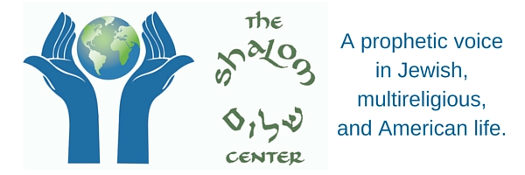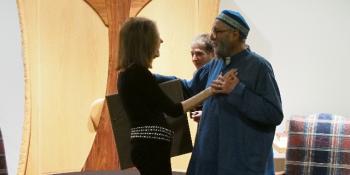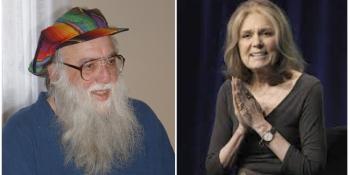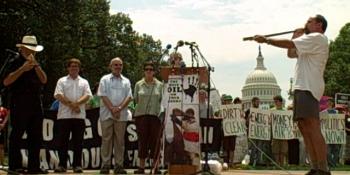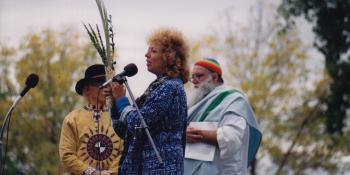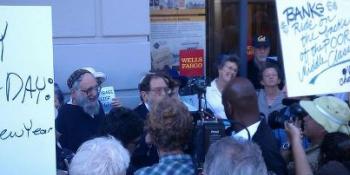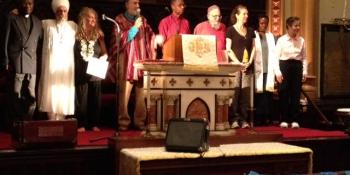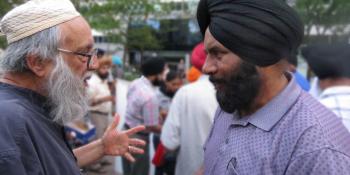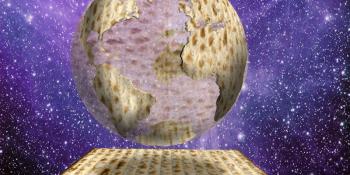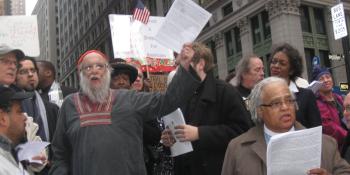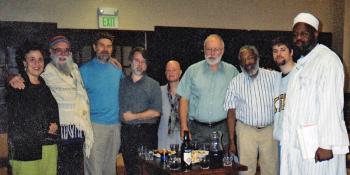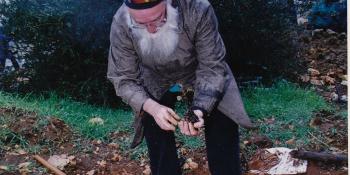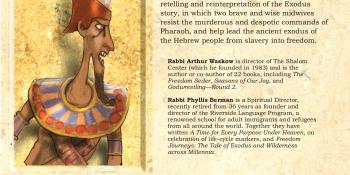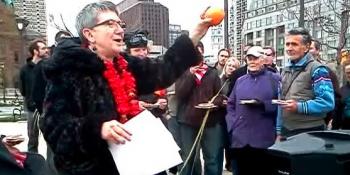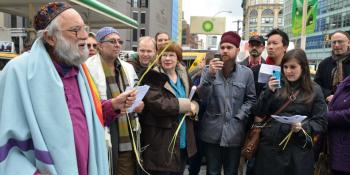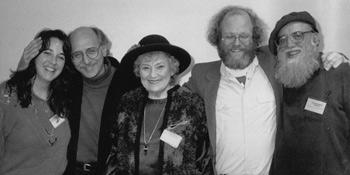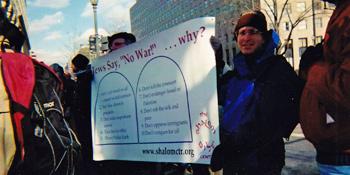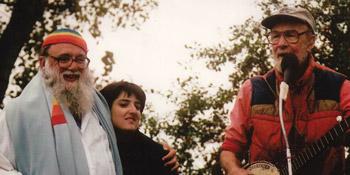Submitted by Rabbi Arthur Waskow on
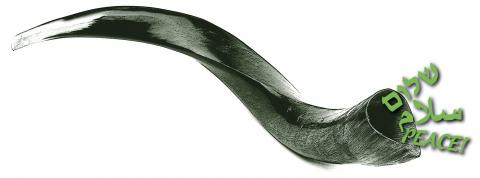
An excerpt from Ben Lorber's interview of Reb Arthur: AW: There are three images we at The Shalom Center use about ourselves: They all start small. First, a shofar. We call out by blowing through the tiny end, calling for Shalom, for Salaam, for Transformation, for the Beloved Community -- and a great arousal happens at the open mouth. Second, a tugboat ...
BL: We could not talk about progressive Jewish identity and spirituality without also talking about what Waskow called “the heart of the matter -- -- the prophetic vision embodied in Judaism, ancient and modern.” We could not talk about Occupy Wall Street without also talking about “the heart of the Freedom Seder…[the] debate between violence and non-violence.” We could not talk about the New Jewish Agenda of the past without talking about the new(er) Jewish agenda(s) of the present.
[By Benjamin Lorber (first published in Tikkun on-line, Aug. 27, 2012). Lorber is a radical journalist and activist who has worked in the U.S. with the migrant justice movement, and in the Middle East with the Palestinian struggle. Throughout 2012, he has worked with “No More Deaths” in Arizona, distributing food, water and medical aid to migrants crossing into the United States.]
Lorber: When I sat down to speak with radical activist Rabbi Arthur Waskow at The Shalom Center in Philadelphia this July, I wanted to talk about the hopes and promises of twenty- first century Jewish activism, Occupy Judaism, and the American Jewish progressive movement.
But most of all, I wanted to discuss Ezra Berkley Nepon’s recently published book Justice, Justice Shall You Pursue: A History of New Jewish Agenda. This book represents the first serious attempt to comprehensively document the 1980s progressive organization New Jewish Agenda (NJA). …
But we found that we could not talk about the New Jewish Agenda of the past without talking about the new(er) Jewish agenda(s) of the present.
We could not talk about progressive Jewish identity and spirituality without also talking about what Waskow called “the heart of the matter -- -- the prophetic vision embodied in Judaism, ancient and modern.” We could not talk about Occupy Wall Street without also talking about “the heart of the Freedom Seder…[the] debate between violence and non-violence.”
We could not talk about the diversity of contemporary progressive Jewish activism without also talking about the issue of Zionism, an issue that, Waskow said, “becomes legitimate when the society around it discovers it has to live with a spectrum of organizations, people, etc. raising the issue.”
We also discussed the YIVO Institute for Jewish Research’s recent conference, entitled ‘Jews and the Left.’ There, voices of lamentation repeated the well-worn mantra that, as Ezra Mendelsohn said, “the Left in general is in eclipse, and the Jewish left is dead in the U.S., an expired product of a past historical epoch … a good chapter in our history, but one which is gone.”
When I repeated this quote to Arthur Waskow, he interrupted me with a look of incredulity…
Arthur Waskow: Did they bother to invite anybody who actually is a Jew on the left? Because there’s Tikkun, there’s The Shalom Center, the Jewish Council for Urban Affairs in Chicago, and a bunch of different organizations!
BL: Throughout ‘Justice, Justice Shall You Pursue,’ Nepon celebrates that NJA upheld itself for over a decade as a multi-issue organization, tackling problems of sexism, racism, and classism both inside and outside the Jewish community, along with a critique of Israel, and presenting a united front of Jewish opposition to the mainstream.
Today, progressive American Jewish organizations exist across the left spectrum as single-issue advocacy groups, often competing with one another for funds, attention and a seat at the table, and struggling to try to influence the mainstream. Do you see this multiplicity of organizations as a weakness of the contemporary Jewish American left?
AW: There are three images we at The Shalom Center use about ourselves: They all start small.
First, a shofar. We call out by blowing through the tiny end, calling for Shalom, for Transformation, for the Beloved Community -- and a great arousal happens at the open mouth.
Second: a tugboat. The big ocean liner can barely change direction; so it needs a tugboat that can change direction, noodging, nudging, pushing up against it. I think we accomplished that metaphor with the Reform movement during the Iraq war. The Iraq war was historically a total disaster, but it also took some nudging for people to get off their habit of total deference towards any President of the United States, and we did help the Reform movement do that.
Third: a seedbed. We can drop tiny seeds that are very small and don’t require much money, and some of them grow big. We see ourselves that way too.
BL: And in many ways NJA throughout the 1980s and early 1990s conceived of itself as a tugboat and a seedbed, steering the tone of mainstream American Jewish discourse towards the left and sowing seeds of dissent on many critical issues well ahead of their time. Today, the seeds that NJA helped plant -– the movement of Jewish feminism, and the movement of Jewish-Palestinian solidarity, to name two examples -– have blossomed into the decisive political debates of our community.
AW: The difference is that NJA wanted to be a mass organization, and briefly succeeded. We were enormously helped by Ronald Reagan’s election. Our first convention was held in the fall after November 1980, after the election, which Reagan won, and many many more people showed up then we expected. Part of the reason for that was that people were shocked and horrified by Reagan’s victory in the election.
BL: Has the progressive Jewish movement experienced a similar revitalization since the early 2000s, with the rise of Bush and the American neoconservative movement?
AW: Not the same way in the American Jewish community. I think maybe Occupy is the first stage of re-energizing the American and Jewish progressive movement.
BL: But today, two decades after the dissolution of NJA, do you see a hole or a void in the community of progressive Jewish organizations that NJA used to fill? Across the diverse spectrum of groups, is there a lack of a unifying thread, an absence of a ‘We?’
AW: There are some interesting things beginning to happen. There’s the Jewish Social Justice Roundtable and the Green Hevra. There’s a serious attempt to create the beginnings, but the one thing it ain’t is a mass movement. It deliberately is an amalgam of organizations, not of people, so that puts limits on it.
BL: An especially powerful legacy of NJA, to me, is its structural emphasis on democratic, horizontal, non-hierarchical decision-making, and organization. These dynamics, with all their pluses and minuses, have re-emerged today most vigorously in the Occupy movement. What does NJA have to teach the present-day Jewish American progressive community in this regard?
AW: I hope, but I’m not convinced, that the Green Hevra model is a useful model. It’s kind of a version of NJA’s decentralization, though NJA’s decentralization was geographic, and Green Hevra’s model isn’t geographic as much as it is functional. Among its member groups are farms, lobbies, direct-action activists, and educators. That makes vigorous action difficult. But it is a different effort to preserve a kind of loosely connected national body, and to encourage participation and debate.
BL: One of the inspiring things for me about the Jewish Occupy events, such as Occupy Kol Nidre, is this tradition of performing Jewish ritual in public as political action. NJA explored this too–as Nepon relates in ‘Justice, Justice Shall You Pursue,’ during Tisha B’av in 1981, which fell on the anniversary of the atomic bombing of Nagasaki by the U.S. during WWII, NJA held a public ceremony near the White House and the Soviet Embassy in Washington, D.C., calling for nuclear disarmament.
AW: When Jews created Occupy Kol Nidre, I hoped it was another great step toward Transformative Judaism that would see the heart of Judaism, not just an appendage, in addressing universal issues through Jewish practice. Because it took Kol Nidre out of the closet, as the original Freedom Seder took the Haggadah out of the closet. About Tisha B'Av: two summers ago we did it on the steps of the US Capitol again, but this time it was to focus on the oil spill that had just happened in the Gulf. We asked, “What is the Temple today?” Today the Temple is the whole Earth. For every culture and every species, the sacred Temple is Earth itself, and the pharaohs of the human race today, like the emperors who destroyed the First and Second Temples, are in the process of destroying our Temple.
And we did this with about 300 people, maybe half of them Jewish, a whole bunch of secular people, and some Christians and Muslims. It was amazing! We chanted, mainly in English, a new version of Lamentations to the melody of Eicha, of Lamentations.
There was a crucial discussion in the Green Hevra a few days ago: what does it mean to take inspiration from theology and challenge people into acting? A bunch of us going off and making Shabbat by ourselves has no impact on society. What if we sat down on Shabbat and somehow interfered with work? I haven’t yet been struck with a spark of how to do that.
Martin Buber said, “Life is not really in the I, life is not really in the Thou. Life is in the hyphen.” Between me and Daniel Sieradski (American Jewish writer and activist), life was in the hyphen! I called him up and asked: “What do you think about doing Kol Nidre at Zuccotti Park?’ He said “Arthur, Kol Nidre! We did Erev Shabbat there last week! But Kol Nidre? I gotta think about it.” And he calls me up the next day and says, “Well, I put it on Twitter and there are 500 people that wanna come!”
I couldn’t do it alone, and he couldn’t do it alone.
BL: As NJA sought to be “a Jewish voice among progressives and a progressive voice among Jews,” Occupy Judaism’s motto today is “bringing the Jews to Occupy Wall Street and bringing Occupy Wall Street to the Jews.” What are the parallels between the two? Is it inspiring to you today that in the midst of the rising of a broad-based American social movement, this tradition of Jewish ritual as public protest has reemerged?
AW: Absolutely inspiring to me, totally! NJA taught us that you can interweave prophetic religious folk and leftist secular folk. I try not to use the ‘left’ label for myself because it has come to mean almost entirely a secular, sometimes even anti -- religious outlook on the world. So I use ‘prophetic’ because for me it embodies both a profound religious sense of contact with God–not at all necessarily according to the structures or the strictures of the prayer book,–and vigorous and radical political action.
During most of its history, NJA was able to weave those strands of thought and action together. I think one of the reasons it collapsed was that some mostly secularist folks thought they couldn’t bear working with people who used ‘God’ language. There was a lot of anger and contempt aimed at religious folk, which ended up in the dismantling of the office and the organization.
This did not come from any grassroots decision -- making; it was made by people in the steering committee. I think that if there had been a consultation of the national membership, people would’ve opposed abolishing the organization.
I thought the closure was a serious ethical and political mistake -- none of which I think is in the book.
BL: A few years after NJA was founded, Michael Lerner founded Tikkun, and there was a return to spirituality in the American Jewish progressive movement that was, in many ways, a continuation of the Fabrangen and radical Hevra movements begun a decade earlier. Do you think this schism between secular and spiritual currents within NJA reflected the larger tensions between a secular humanist Jewish movement and a Jewish renewal movement?
AW: Yes, I think that’s right. And both trends have survived. The heart of the matter for me is the prophetic vision embodied in Judaism, ancient and modern, all the way to Buber and Heschel and Judith Plaskow. So that strand for me is the point, and acting on that strand for me is not bringing Occupy Wall Street to the Jews, it is bringing Isaiah and Heschel and Lerner and Waskow to the Jews.
Here’s an example of the problem and the gift. Occupy Wall Street breaks through in American consciousness to get the notion of the 99% and the 1% across. Brilliant! Terrific! Now, for twenty years the Shalom Center has been talking about the pharaohs of our generation, which I think is the 1% in Jewish clothes (and I don’t mean only governments, but corporations as well).
So it’s true that Occupy broke through in the American public a way that, inside the Jewish community, the Freedom Seder did break through -- in an unexpected way. [The Freedom Seder] told everyone that we can all create our own liberating seders! And that changed the attitude of lots of Jews towards the existing liturgy.
BL: Reading the Freedom Seder today, I was drawn to the debate between violence and non-violence as a tactic for social change. Pacifist quotes by Martin Luther King Jr. are back-to-back with celebrations of the race riot, and quotes by Malcolm X advocating change ‘by any means necessary.’ This seems to be especially pertinent today, as popular unrest in America and worldwide straddles the border between non-violent and violent resistance.
AW: When I said that the race riots were about the confrontation between the "Israelites" in the streets and "Pharaoh" in the army, sure! The heart of the Freedom Seder was a debate between violence and non-violence. I have since become convinced that Kingian, Gandhian non-violence is far better. I’m not an absolute pacifist, but I think it’s far better except in a very few situations, where there is such a tyrannical thing that the only way to resist is physically. But at the time of the Freedom Seder I was saying: “Let’s have the argument, because we can only gain wisdom from the argument.”
BL: The issue of Zionism has obviously had a huge and polarizing influence of the progressive Jewish Left since the 1960s. How has the discourse on Palestine changed from the 1970s to today on the Jewish Left?
AW: There’s more of a spectrum now. Jewish Voice for Peace (JVP) can exist alongside J Street, and both of them can exist. I think there is a big majority among actual flesh -- and -- blood American Jews for the J Street outlook, but their organizations don’t carry out that view.
Why? For some, it’s the sheer power of the bosses and donors and legitimacy-brokers who kowtow to Israeli officialdom.
For others, even if a majority support J Streetish approaches, if there is a minority that screams and yells in support of Israeli government policy, organizations don’t like to confront even small minorities. So the organization shuts up.
This is especially a problem for organizations that feel they are barely treated as legitimate anyway. There are two ways to behave if you think you are being treated by the big boys as barely legitimate. One is to say ‘fuck you!’ and do whatever really bold and trouble-making stuff you wanna do. The other one is to be very careful not to annoy people.
JVP has done the first, and I sort of feel attracted to its tone and method, but I see a problem with its unwillingness to affirm the full legitimacy of Israel as a state, aside from its disgusting illegitimate Occupation. That would affirm the right of the Israeli people to make their decision about having an Israeli state, and therefore to reaffirm that we can only go beyond a two-state solution if each of the two peoples says they’re ready to go beyond it. As of now, Israeli society is not willing to go beyond a two- state solution.
For me, JVP doesn’t have to say: “We support a two state solution,” but it does have to say: “We support a solution to which the existing state of Israel and its people agree.” And they don’t quite do that.
So that’s one of my problems with it, and I think it’s probably a problem with a lot of people who would otherwise feel attracted to JVP. On the other hand, there are a lot of people who do feel attracted to JVP, because they do indeed say ‘fuck you’ to the Federation world and all that.
So the very fact of a more diverse spectrum means that the repression has not been able to succeed as much. In a way, an issue becomes legitimate when the society around it discovers it has to live with a spectrum of organizations, people, etc. raising the issue. It’s easy to polarize and expel, to excommunicate so long as there is a clear separation between viewpoints. But most Americans from Peace Now and J Street bridge the gap enough that it’s clearly impossible now to wipe out that kind of energy.
I’m not so happy with J Street either, by the way. J Street established this metaphor of itself that it was going to watch Obama’s back. And I ask, “What about his front? What about confronting him when he doesn’t do what makes sense?”
Their whole description of their role was that whenever people were beating up on Obama for being too pro-peace or too critical of Israeli policy, J Street would hold his back and argue that he’s okay. But when he insisted on vetoing the Palestinians’ bid for recognition at the U.N., for instance, J Street was not prepared to say, “Oh, that veto was a bad mistake.” So I didn’t go to the last convention.
If I could wave my wand and there would be an organization that laser-beam boycotted the products created in the West Bank, period, I would do it. Peter Beinart (an influential American Jewish journalist), Lerner and I are not just liberal Zionists; we’re something more than that. Lerner does try to organize around it and has done more to unite the two approaches than most anybody, including the Shalom Center.
BL: In 2009, you cited five American ‘pro-Israel, pro-Peace’ Jewish organizations that were worth supporting in a context of increasing polarization within the American Jewish community: Meretz USA, Americans for Peace Now, Rabbis for Human Rights, J Street, and Jewish Alliance for Justice and Peace (Brit Tzedek v’Shalom). Daniel Lang/Levitsky stated that since 2009, “U.S. Zionist ‘peace’ -oriented groups like Brit Tzedek, J Street, and the Tikkun Community have continued to decline in influence, visibility, and effectiveness, while non - and anti -Zionist projects from JVP to Jews Say No to the International Jewish Anti-Zionist Network (IJAZN) have steadily grown in both size and strength.” Do you see this trend? Why?
AW: Yes, about JVP. No, about the others. And yes, about the mood of the disaffected who don't belong to any organization. It's because people are getting more and more fed up with the ever more disgusting behavior of the Israeli government. The worse it gets, the more people that say “I’m not interested in Israel, I'm not even interested in J Street.” So J Street tries to walk this very difficult line, but I don’t think the line has to be as wishy-washy as they make it.
BL: What, to sum up, can Jewish occupiers, and the entire Occupy movement, draw from prophetic Judaism? What can the prophetic Jewish heritage teach us about this imperative to resist, to speak the truth to power?
AW: I got imprinted by the Freedom Seder on two aspects of exciting Jews to work for change. One aspect: Behind any specific "issue," any specific oppression, is Pharaoh. Top-Down arrogant oppressive power. Second aspect: Beneath an effective resistance to Pharaoh is spiritual energy, covenant, the Burning Bush, the InterBreathin of all life.. For me, that spiritual energy rises often in the festivals, just as it did for me in 1969. You might say I’ve just been reworking that metaphor for forty-some years, and in some ways that’s true. Hanukkah, the green menorah, a Tree of Light. Tisha B'Av, the burning Temple of the Earth. And all the rest.
But I have gone much deeper into that metaphor. Indeed, Freedom Journeys, my most recent book with Rabbi Phyllis Berman, my wife, is about the Exodus and the wilderness at a far deeper level than the Freedom Seder. I spiraled back to my beginning to get to a new and deeper place. No accident that doing that required Phyllis!
I think that the Exodus/ Wilderness is the master Jewish story, whether it’s fiction or history.
We begin that book with these three lines: “If the Pharaoh fell in the Red Sea and nobody told the story, did it happen? No. If no Pharaoh fell in the Red Sea but we told the story for three thousand years, did it happen? Yes. Is it still happening? Yes.”
BL: I love Sieradski’s quote, in an article for the Forward in November 2011, where he asserts the direct identity between the values of Judaism and those of Occupy -- “In retelling our story (“We are the 99%”), recounting our values (“social and economic justice for all”) and carrying forth our tradition unto the four corners of the Earth (“Occupy Everywhere”) we are empowered to bring the spirit of the occupation into every facet of our lives.”
AW: Exactly!
